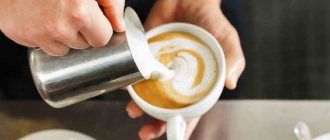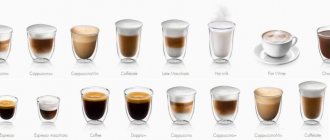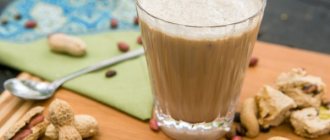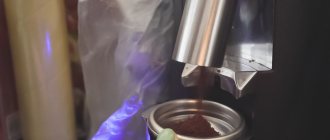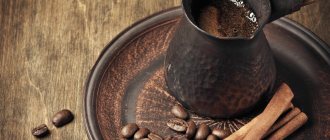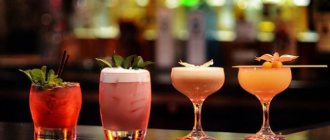Do you like coffee? A negative answer to this question is extremely rare. This drink, whose history goes back more than 700 years, is popular in all corners of the globe. The number of varieties and types of its preparation cannot be counted. Every country has traditions associated with it, cooking secrets that allow it to impart a special taste and aroma.
How to make cappuccino correctly
The main condition for preparing a classic cappuccino is milk that is perfectly frothed and poured into the finished espresso. To obtain lush foam, milk must have a temperature of +4°C. The fat content of milk should not be less than 3.5%. In proportion, the composition of cappuccino coffee should be:
- 1.3 volumes – espresso;
- 1.3 hot milk;
- 1.3 foam.
The standard portion coming out of these products is 150 -180 ml.
To get a cappuccino, add frothed milk to espresso. Milk foam covering the surface of the drink keeps it hot for a long time. A special ceramic demitasse coffee mug also holds heat perfectly. Its volume is 180 ml. The cups are preheated and their thick walls can maintain the temperature of the coffee drink for a long time. Its temperature should be 65-70°C.
The best coffee beans
| 2022 stamp | Flaws | Type of grains | Roasting | Compound | Yandex Market |
| Molinari 5 Stars 100% Arabica, vacuum tin 3 kg | Expensive | Arabica | average | 100% Arabica | Go |
| Blaser Lilla & Rose | only for coffee machines | Arabica/Robusta | average+ | 80% Arabica, 20% Robusta | Go |
| Julius Meinl Jubileum, 250 g | weak | Arabica/Robusta | average | 80% Arabica, 20% Robusta | Go |
| Tasty Coffee Espresso Honduras San Marcos, soft pack 1 kg | only for coffee machines | Arabica | dark | 100% Arabica | Go |
| LavAzza Tierra Brasile, 1 kg | only for coffee machines | Arabica/Robusta | average | 70% Arabica, 30% Robusta | Go |
| Egoiste Noir, 1 kg | not found | Arabica | average | 100% Arabica | Go |
| Illy Ethiopia, 250 g, tin | weak | Arabica | average | 100% Arabica | Go |
| Paulig Presidentti Black Label, soft pack, 250 g | not found | Arabica | dark | 100% Arabica | Go |
| Bushido Red Katana, 1 kg | no discounts dear | Arabica | average | 100% Arabica | Go |
| Jacobs Barista Editions Crema, 230 g | no discounts dear | Arabica/Robusta | average | — | Go |
Preparing cappuccino
If you have a coffee machine at home, then you don’t need to be an expert in making cappuccino. The coffee machine program includes different types of coffee, including cappuccino. But the beauty of making coffee is by hand.
To prepare one serving you will need:
- Ground coffee – 2-3 teaspoons;
- Water – 250 ml;
- Sugar – 2-3 tsp;
- Milk - 3.5% - 6% - 70 ml;
- Cinnamon.
To froth milk, it is better to take a whole and natural product. If there is no fat milk, then you can use 10% cream. The foam from the cream is denser and higher, but it does not diffuse as well with the coffee. After all, cappuccino is the diffusion of foamed milk throughout the entire depth of the drink.
A geyser coffee maker is best suited for espresso. But, you can use a regular Turkish press and a French press. It is recommended to strain Turkish coffee, as espresso should not contain sediment.
You need to pour water into the lower compartment of the geyser coffee maker to a certain level. Then you need to install the filter and add coffee. Stronger espresso is obtained if the filter is tightly filled with ground beans. Now you need to close the coffee maker and put it on low heat. Readiness is determined by the stop of hissing from the coffee maker. It must be immediately removed from the heat at this moment.
Milk foam is excellent when frothing milk in a mixer. To do this you need to warm it up a little. A French press also whips milk foam well. You should get a light, air-rich foam that will not disappear from the surface of the cup until the last sip of the drink. By combining espresso with milk foam, we get cappuccino. Sprinkle the foam with cinnamon on top.
Rating of the best coffee beans
Molinari 5 Stars 100% Arabica, vacuum tin 3 kg
Mild taste, pleasant aroma, original packaging - this is all about Molinari 5 Stars. The Italian product belongs to the premium segment of the coffee market. 100% consists of Arabica beans collected in Kenya, Costa Rica, Brazil, Colombia, Honduras.
Thanks to a sufficient amount of selected green beans, as well as a medium degree of roasting, it has the perfect balance of light sourness with barely perceptible sweetness and pleasant bitterness. Packaged in an airtight tin, thanks to which it retains its freshness and aroma for a long time. Recommended for making espresso in coffee machines.
| Type of grains | Arabica |
| Roasting degree | average |
| Compound | 100% Arabica |
| Price, rub | 10 100 |
| Find in store | Yandex Market |
Advantages and disadvantages
- mild taste without harsh and pronounced shades;
- absence of unpleasant bitterness;
- fresh aroma of beans (thanks to sealed tin packaging);
- drink density, silky texture;
- alternative preparation methods (not only in coffee machines).
- you need a special key to open the jar;
- changes in flavor bouquet, density, richness with alternative cooking methods;
- high price.
Blaser Lilla & Rose
The product of the Swiss brand has an unusual floral-spicy taste with a slight bitterness, which even sophisticated gourmets like. Contains 80% washed Arabica and 20% Robusta. The beans are roasted at medium level, which gives the drink a rich aroma.
The flavor bouquet is revealed by distinct notes of rose and lily, complemented by caramel, honey, and hazelnuts. The coffee is quite dense and has a creamy texture. It is used by professional baristas not only in coffee shops, but also at various competitions and championships for preparing drinks.
| Type of grains | Arabica/Robusta |
| Roasting degree | average+ |
| Compound | 80% Arabica, 20% Robusta |
| Find in store | Yandex Market |
Advantages and disadvantages
- original taste, pleasant bitterness;
- perfect balance of bitterness, sweetness, acidity;
- combination with milk;
- dense body of the drink with a crema texture;
- delicious cappuccino;
- convenient packaging with a capacity of 250 g.
- recommended for preparation only in coffee machines (with alternative methods, taste characteristics and aroma are lost);
- high price.
Julius Meinl Jubileum, 250 g
The 2022 ranking continues with grain coffee, the packaging of which with the Moorish logo is recognized all over the world. The Jubileum series was created in honor of the 100th anniversary of the manufacturing company. Consists of 80% Arabica and 20% Robusta, grown on plantations in Papua New Guinea.
The beans are roasted using Viennese technology to medium. They produce coffee without bitterness, with a pleasant aroma, subtle notes of citrus and flowers. The drink has a rich taste and has minimal sourness, and after each sip you feel a pleasant sweetness in your mouth.
| Type of grains | Arabica/Robusta |
| Roasting degree | average |
| Compound | 80% Arabica, 20% Robusta |
| Price, rub | 529 |
| Find in store | Yandex Market |
Advantages and disadvantages
- delicate taste, there are notes of citrus and flowers;
- persistent foam in the cup;
- lack of bitterness, acid;
- sweetish aftertaste;
- dense texture;
- ideal for a coffee machine;
- affordable price.
- weak (opinion of several users).
How to make cappuccino from instant coffee?
If you don’t have a Turk or coffee maker in your house, then cappuccino can be made from instant espresso. Of course, true cappuccino connoisseurs may be offended by this approach to the drink, but, as they say, “no fish, no fish.” To prepare ersatz cappuccino you will need:
- Instant coffee – 2 tsp;
- Sugar – 2 tsp;
- Milk – 100 ml;
- Water – 100 ml.
Beat lukewarm milk in a mixer or blender. Add sugar to a cup of coffee powder and add hot water. Transfer the finished foam into a cup with instant coffee drink. If necessary, you can sprinkle grated dark chocolate or cinnamon on top.
Monosort or blend: what to choose
A blend is a mixture of grains of different varieties. Each roaster selects several single-origin varieties in order to balance the taste characteristics and achieve the desired density of the drink, texture, and aroma. In addition to taste, the cost of the future blend is also taken into account.
Single varieties include Arabica and Robusta. If the first is used in its pure form, then the second is most often used in mixtures. Due to the strength, astringency, acidity, and high caffeine content, not everyone can drink a cup of 100% Robusta coffee.
| Pure Arabica | It has a mild taste, delicate aroma, and slight sourness. |
| Pure Robusta | Pronounced astringency, high strength, too rich taste. |
| Mixture | Allows you to balance richness, sweetness, acidity. |
Interesting! The most successful is considered a blend of 80% Arabica and 20% Robusta. If you prefer stronger coffee drinks with a pronounced taste, then choose a mixture in the ratio of 60-70% Arabica to 40-30% Robusta.
Difference between cappuccino and latte
Today, various espresso-based recipes are offered for coffee connoisseurs. Let us clarify that espresso is obtained by filtering coffee powder with hot water under high pressure. It can be prepared only in special coffee makers or coffee machines. In addition to cappuccino, you can also prepare coffee latte, which is familiar in Russia, using espresso. For inexperienced coffee drink lovers, it can be difficult to choose between cappuccino and latte. What is the difference between these two types of the same coffee? Their differences can be listed in several theses:
- They have different proportions in their composition. In cappuccino, the ingredients are in equal parts. The proportions for a latte are: 1 part espresso: 1 part foam: 2 parts milk. That is, a latte is less concentrated than a cappuccino;
- Essentially, a latte is an espresso-based cocktail;
- Cappuccino and latte are served in different ways. Cappuccino is poured into cups not exceeding a volume of 180 liters, and according to the rules, latte must be served in tall cocktail glasses with a capacity of up to 360 ml.
Well, the most significant difference between a real cappuccino and a latte is its tart, rich taste and thick aroma. Latte has a much weaker taste and aroma.
Classification of coffee varieties
The main supplier of beans that are used for invigorating aromatic coffee is the coffee tree. Today they number more than seventy representatives.
However, it should be noted that not all varieties have the proper aroma and taste characteristics. Therefore, the modern coffee industry uses only a few types of coffee beans to prepare the drink. These are Arabica, Robusta and Liberica. This classification arose back in the eighteenth century.
Arabica is the best and most valuable species in the world. Its taste and rich aroma are simply ideal among lovers and admirers of this drink. This directly affects the industrial importance of Arabica. It should be noted that the largest percentage of coffee produced in the world is made from Arabica beans. Such trees are located in different countries and continents. Specific conditions and features of the specific location of trees greatly influence the taste characteristics of the fruit.
Although Arabica is very popular, it is very difficult to grow this variety. It is capricious and exposed to temperature changes, various diseases and pests. These facts partly explain its high cost compared to others.
Robusta is inferior to Arabica in taste and aroma. Therefore, its percentage in industry is much smaller. But Robusta also has its own advantages, which put it in second place among types of coffee. Firstly, this variety is not so picky about growing conditions. Secondly, it is much stronger than the previous one, which allows these grains to be used in different mixtures when creating a soluble product.
Return to content
How to drink cappuccino correctly?
In order to fully taste the cappuccino, it should not be stirred. Gourmets get great pleasure from passing coffee with milk through airy foam. Sugar is also unacceptable for connoisseurs of this drink. It brings out a real bouquet of taste and aromatic sensations. Cappuccino is an Italian invention. Therefore, Italians consume it around 11 am, almost noon. Under no circumstances should cappuccino be mixed with food. This is considered blasphemy to the drink. And, in addition, milk during meals and after meals does not contribute to the normal functioning of the digestive system.
Well, let's follow the example of the Italians, drink cappuccino coffee correctly and get benefit and pleasure from it.
Categories Specialty or commercial: what kind of coffee do we drink?
Coffee lovers can be divided into two groups. For some (and these are the majority!) coffee is an invigorating drink that allows you to wake up faster in the morning and get to work, and have a pleasant time with friends at lunchtime or in the evening. Such a product is called commercial and is supplied to the market in large quantities. The grains for its production are selected less demandingly, and budget brands are not of the best quality.
Basically, buyers are offered blends (mixtures) from harvests of different varieties and even regions. Here we need to make a reservation: mixing beans collected not only from different plantations, but also countries, leads to the loss of the original taste and individual aroma of the finished drink.
The second group of coffee lovers includes gourmets who primarily value:
- taste characteristics;
- density;
- texture;
- aftertaste.
Such buyers pay attention to the blend, region and harvest time. They prefer Arabica beans collected on highland plantations (at least 1 km above sea level). After all, only high in the mountains do coffee trees literally have to survive by giving all their juices to the fruits. And this increases the quality of the grains and their cost. Allows you to produce specialty coffee with a rich bouquet of taste and aroma.
On a note! Specialty coffee is made only from Arabica beans and occupies only 10% of the sales market in 2022. The grains are strictly checked for defects, sorted, and undergo special processing.


